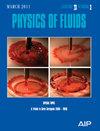低雷诺数下坠落板块的动力学特性
IF 4.3
2区 工程技术
Q1 MECHANICS
引用次数: 0
摘要
物体在流体中自由下落是自然界和工程界的普遍现象。下落物体的下落方式受到物体和流体特性的影响。我们假设自由落体在低雷诺数时的最终状态是稳定的,等同于固定物体在流入流体时的状态。结果发现,平板会表现出多个稳定下落解。稳定下落解的数量取决于平板重心的位置。多解区的分布受阿基米德数(Ar)和密度比(m*)的影响。由于板的下落是一个动态过程,因此板的实际下落结果并不总是与静态插值法得出的结果一致。我们模拟了重心位于多解区的平板在不同初始释放角 θ0 下的下落行为。根据板的下落行为,在多解区观察到并标出了四个区域:(1) 单一稳定区;(2) 双稳态区;(3) 单一稳定和飘动区;(4) 双稳态和飘动区。评估了 Ar、m* 和板的无量纲惯性矩 I* 对四个区域分布的影响。本文章由计算机程序翻译,如有差异,请以英文原文为准。
Dynamics of a falling plate at low Reynolds numbers
Free-falling of objects in fluids is universal in nature and engineering. The falling styles of the falling object are affected by the properties of both the object and the fluid. Based on the assumption that the final state of a free-falling object at low Reynolds numbers is stable and equivalent to that of a fixed object with incoming flow, we utilize the results for the fixed plate to interpolate and obtain the state of the falling plate. It is found that the plate would exhibit multiple stable falling solutions. The number of stable falling solutions is dependent on the location of the gravity center of the plate. The distribution of the multi-solution region is affected by both Archimedes number (Ar) and the density ratio (m*). The results of the actual fall of the plate do not always agree with those obtained by the static interpolation method due to the fact that the fall of the plate is a dynamic process. We simulate the falling behaviors of plates whose center of gravity is located in the multi-solution region for different initial release angles θ0. According to the falling behaviors of the plate, there are four regions that are observed and denoted in the multi-solution region: (1) single stable region; (2) bistable region; (3) single stable and fluttering region; and (4) bistable and fluttering region. The effects of Ar,m*, and the dimensionless moment of inertia I* of the plate on the distribution of the four regions are evaluated.
求助全文
通过发布文献求助,成功后即可免费获取论文全文。
去求助
来源期刊

Physics of Fluids
物理-力学
CiteScore
6.50
自引率
41.30%
发文量
2063
审稿时长
2.6 months
期刊介绍:
Physics of Fluids (PoF) is a preeminent journal devoted to publishing original theoretical, computational, and experimental contributions to the understanding of the dynamics of gases, liquids, and complex or multiphase fluids. Topics published in PoF are diverse and reflect the most important subjects in fluid dynamics, including, but not limited to:
-Acoustics
-Aerospace and aeronautical flow
-Astrophysical flow
-Biofluid mechanics
-Cavitation and cavitating flows
-Combustion flows
-Complex fluids
-Compressible flow
-Computational fluid dynamics
-Contact lines
-Continuum mechanics
-Convection
-Cryogenic flow
-Droplets
-Electrical and magnetic effects in fluid flow
-Foam, bubble, and film mechanics
-Flow control
-Flow instability and transition
-Flow orientation and anisotropy
-Flows with other transport phenomena
-Flows with complex boundary conditions
-Flow visualization
-Fluid mechanics
-Fluid physical properties
-Fluid–structure interactions
-Free surface flows
-Geophysical flow
-Interfacial flow
-Knudsen flow
-Laminar flow
-Liquid crystals
-Mathematics of fluids
-Micro- and nanofluid mechanics
-Mixing
-Molecular theory
-Nanofluidics
-Particulate, multiphase, and granular flow
-Processing flows
-Relativistic fluid mechanics
-Rotating flows
-Shock wave phenomena
-Soft matter
-Stratified flows
-Supercritical fluids
-Superfluidity
-Thermodynamics of flow systems
-Transonic flow
-Turbulent flow
-Viscous and non-Newtonian flow
-Viscoelasticity
-Vortex dynamics
-Waves
 求助内容:
求助内容: 应助结果提醒方式:
应助结果提醒方式:


